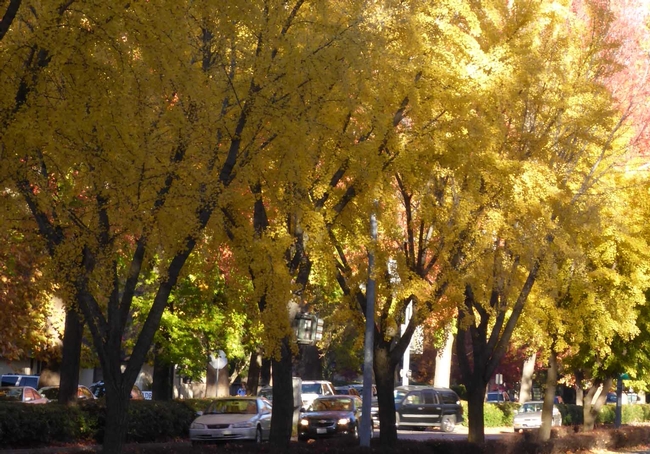By Barbara Ott, Butte County Master Gardener, January 8, 2016.

During the long days of summer sunlight, trees cast shade created by leaves that use sunlight to convert water and carbon dioxide into sugar. This is the process of photosynthesis, which feeds the tree and its leaves. Chlorophyll, responsible for the green color we see in leaves, is an important pigment that absorbs the light energy used in photosynthesis. As days grow shorter and temperatures begin to cool, trees respond by producing less chlorophyll, and photosynthesis slows and eventually comes to a stop. When that happens, pigments of yellow, orange and brown in the leaves (called carotenoids) begin to show through. Some trees produce pigments called anthocyanins in their leaves during the fall, creating red leaves.
A severe drought can delay the arrival of fall color by a few weeks. A dry fall with plenty of warm sunny days and cool nights contributes to vibrant late fall foliage.
Deciduous trees begin to release their leaves when cool temperatures trigger a hormone that sends a chemical message to the leaves to “let go.” Located where the leaf stem meets the branch is a thin bumpy line of microscopic cells called Abscission cells. These cells “cut” the leaf away from the stem when they receive that message. When the air moves them, these dangling leaves fall away. If the abscission cells do not develop, wind will not blow the leaves off. This is why some trees keep their brightly-colored fall foliage long after most other trees have dropped their leaves.

The yellow, orange and brown carotenoid colors in leaves remain fairly constant from year to year. Carotenoid is always present under the chlorophyll and does not change in response to weather. But when a series of warm autumn days and cool non-freezing nights occurs, it's a good year for red fall foliage. The warmth allows the leaves to produce sugar through photosynthesis, but the cool nights prevent the sap from flowing through the leaf into the branches and trunk.
Scientists offer several reasons for why some trees produce the anthocyanin that leads to bright reds. Primarily, it seems that anthocyanins protect leaves from excess sunlight and enable trees to recover remaining nutrients. This helps trees prepare for the next growing season. Anthocyanins give leaves their bright shades of red and purple. So, thanks to the warm days and cool nights we had this past fall, we enjoyed spectacular, vibrant leaf color all autumn long.